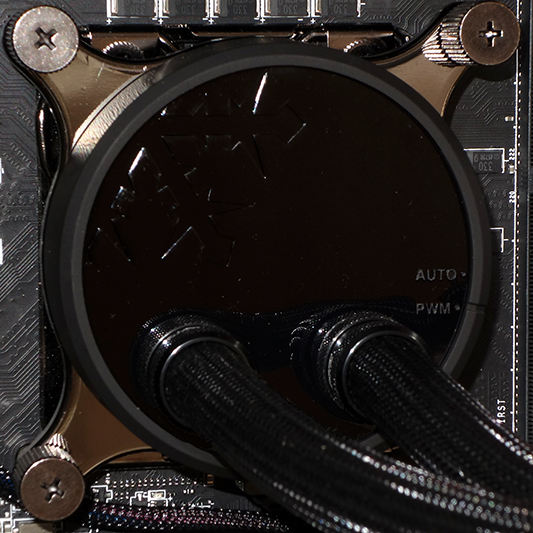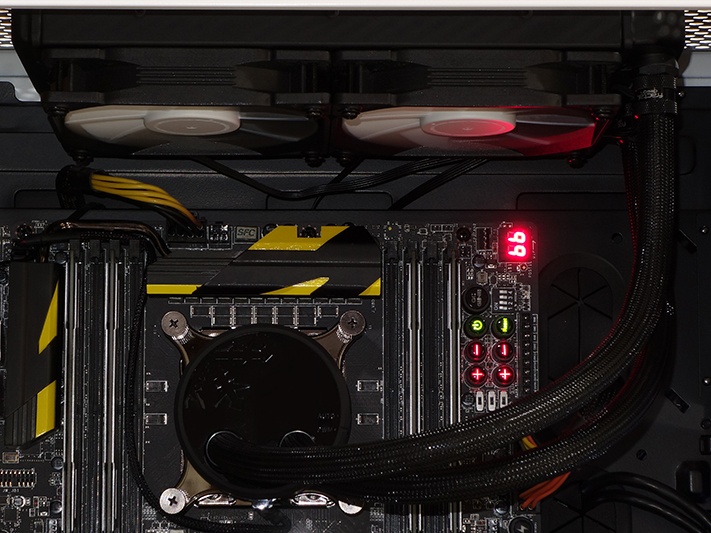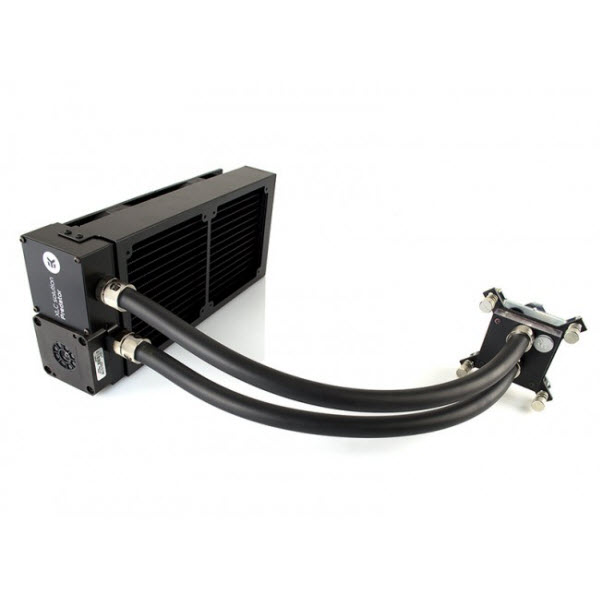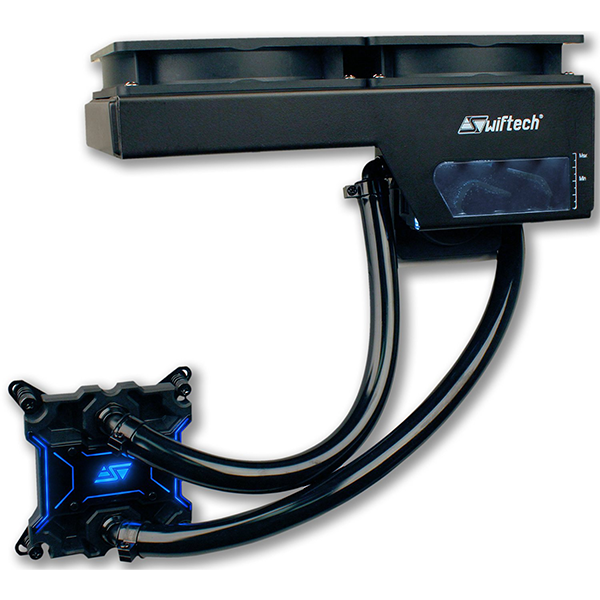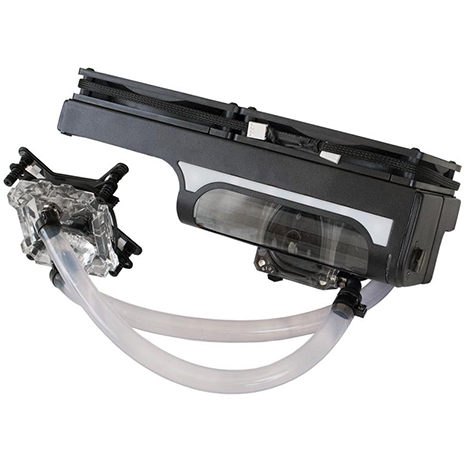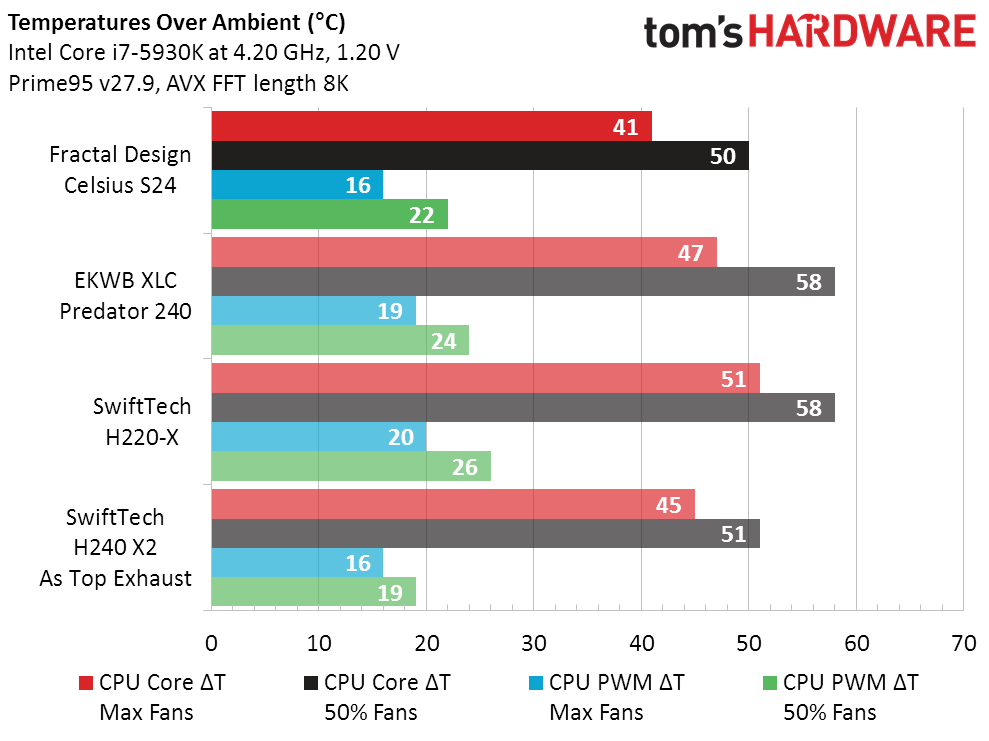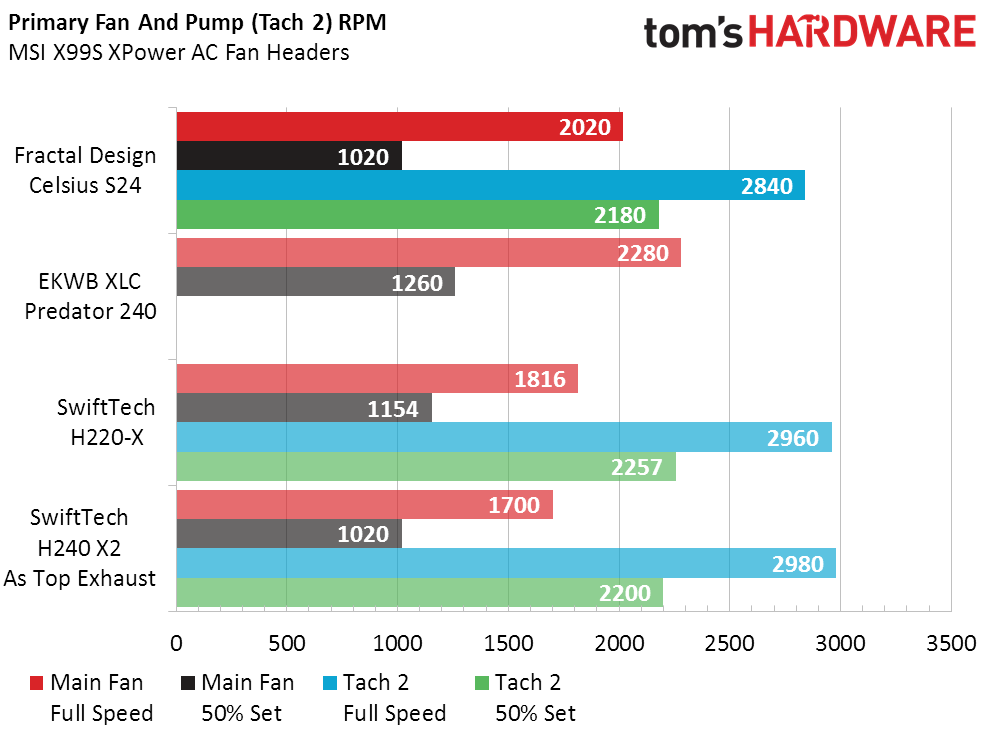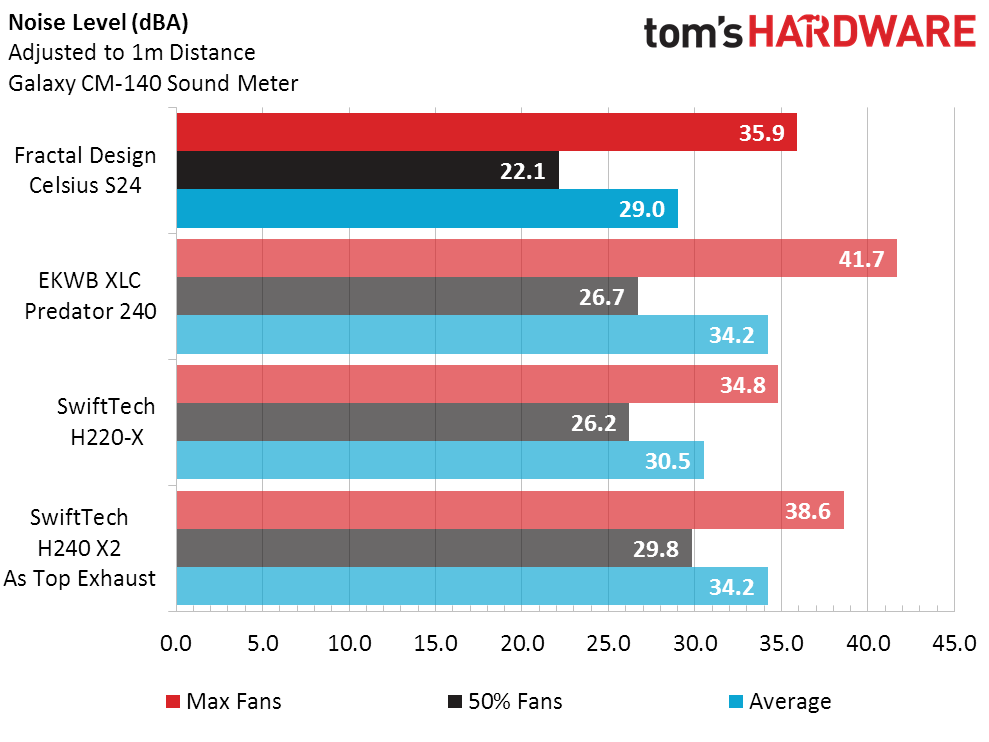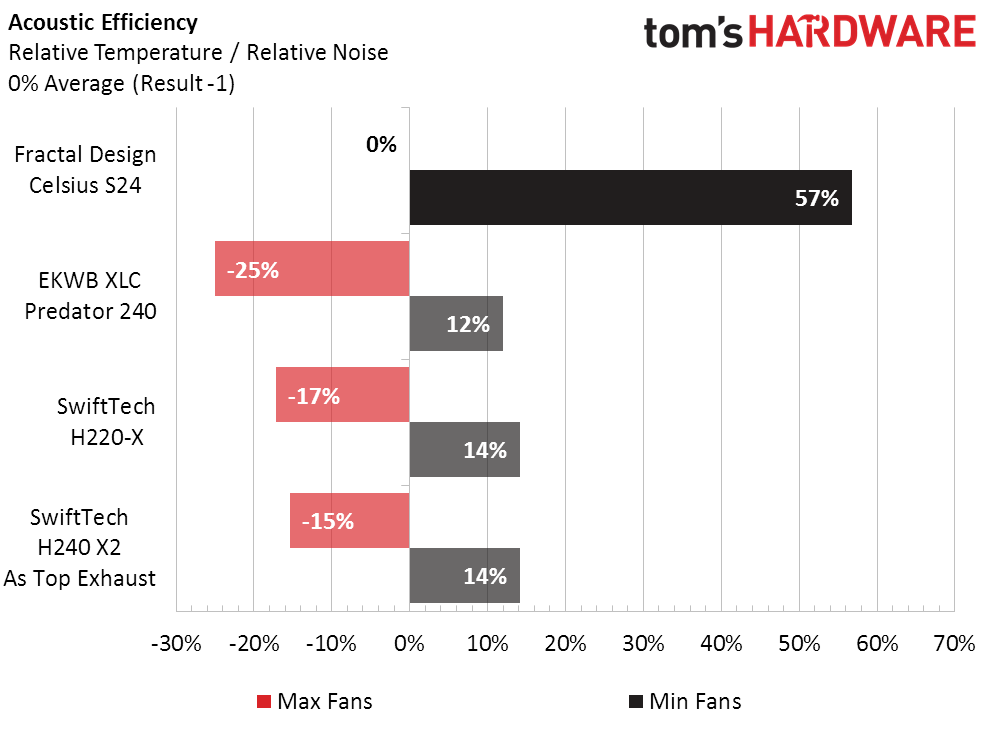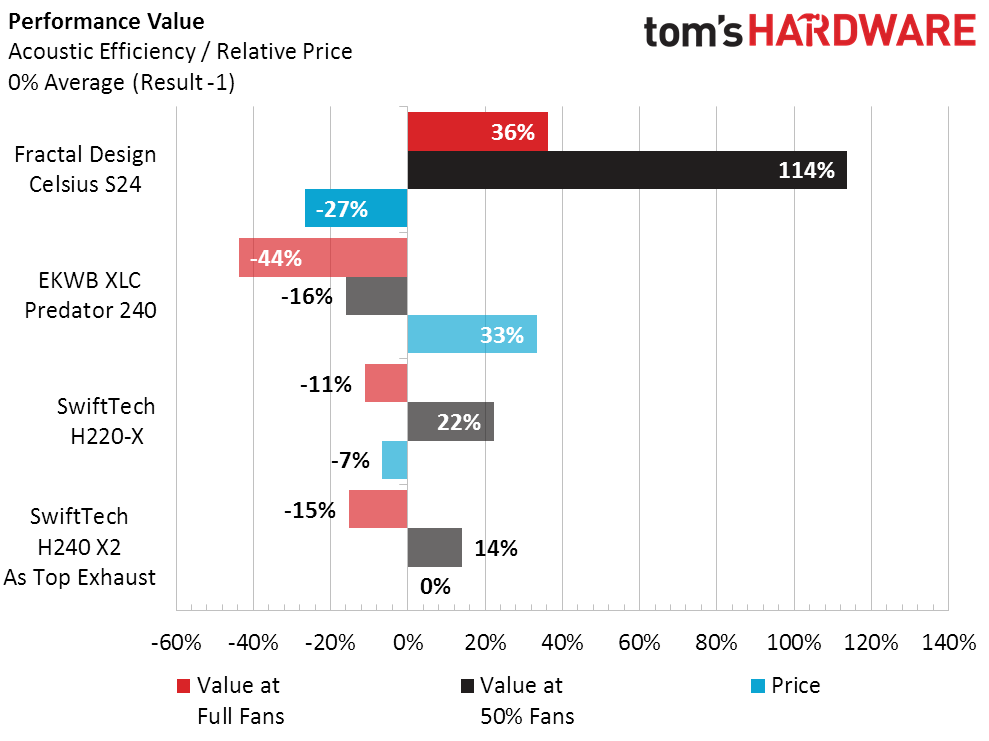Fractal Design Celsius S24 Cooler Review
Why you can trust Tom's Hardware
Installation, Evaluation & Conclusion
We retain the hardware configuration from previous big cooler reviews while comparing the Celsius S24 to previously reviewed rivals. To retain the stock fan configuration of its Corsair 760T case, we remove the magnetic top vent cover and put our radiators there. Because the case has more intake than exhaust fans, optimal airflow is usually achieved with radiator fans blowing upward and out of the top panel. This also happens to be the orientation shown in the Celsius S24 installation guide.
LGA 115x (1156, 1155, 1150, 1151) interfaces require builders to thread standoff-style mounting posts through the board and into the included support plate. LGA 2011x users (2011, 2011-v3) get a different set of standoffs that use the board’s integrated socket support. AMD users get here by removing the original clip bracket from their motherboards and screwing on either the old-fashioned or new-style posts that are shown on the previous page of this review.
The head unit is then mounted over the posts and secured with cap nuts. A ring that encircles the pump body may be turned to select between internal (temperature based) or external (motherboard PWM-based) speed controls, affecting both the pump and fan motors simultaneously. We chose PWM because our motherboard is capable of reading temperature signals directly from the CPU’s internal thermal diode.
Though the included hoses are 15.25” long, straight fittings on the head unit require builders to also consider the amount of tubing required for any bend. These would have been barely long enough to reach the front pane of our case had we decided to ditch the original fan configuration that has been used for the past two years of CPU cooler reviews.
Comparison Products
We’re using the aforementioned big cooling test rig and identical test methods to compare Fractal Design’s Celsius S24 to the only three other pre-filled open loops we’ve tested: the XLC Predator 240 from EK, plus Swiftech’s H220-X and H240 X2. Note that Swiftech uses its own naming scheme where “220” means two 120mm; and note that the H240 X2’s two-by-140mm radiator is larger than those of the other samples.
Test Results
Fractal Design’s Celsius S24 runs cooler than other factory-filled open loops. In fact, it produced the lowest full-load CPU temperature ever measured on this test system. Surely that means it uses higher fans speeds and noisier hardware, right?
Fractal Design’s fans are a little faster than Swiftech’s, but not EK’s. And the Predator 240 doesn’t even have a tachometer output for its pump, as found on the Fractal Design and Swiftech prebuilt kits.
Get Tom's Hardware's best news and in-depth reviews, straight to your inbox.
Remember how Fractal Design rated one fan at 32.2 decibels and we said that the second fan would increase noise to 35.2 decibels? Those don’t appear to be unrealistic numbers, as pump noise also contributes to its 35.9 decibel full-speed reading. Only the H220-X was able to beat it in quietness, and then only when comparing the high (max speed) readings of each unit.
Because inferior coolers have often used outrageous fans to produce competitive temperatures, Acoustic Efficiency (aka “cooling-to-noise ratio") is the true measure of performance. The Celsius S24 combines cool temperatures and low noise for a knock-out in this overall performance metric.
While an overall performance win is a great start, it wouldn’t mean much if nobody could afford the winning part. Fortunately, the Celsius S24 is significantly cheaper than its more traditional rivals.
With better cooling performance, better acoustic performance, and less noise than competitors, where could buyers of the Celsius S24 go wrong? What’s missing that could make it so inexpensive? Well, to begin with, the Celsius S24 has no fill port, and that means you’ll probably have to take it out of your system and lay it flat to fill it. Of course, you could add an in-line fill port, and at this price that doesn’t even sound like a big sacrifice.
Yet the Celsius S24 isn’t perfect, as its integrated pump is rated at less than one liter per minute. Fractal Design literature quotes 40LPH, which translates to a mere 2/3 of a liter per minute. The EK pump has four times the flow rating, and the Swiftech pumps are rated four times higher still.
[Editor's note: We asked Fractal Design whether it sees any issues with adding a standard GPU block to the Celsius loop. Josh Smith, VP of marketing at Fractal Design, said that the company doesn't see any challenges, and that Celsius was tested in more complex loops during its development. In addressing the issue of flow rate, especially where competitors with open loop coolers are concerned, Josh drew our attention to the particular configuration of the Celsius product, saying: "If by Open Loop coolers you are referring to just that, separate components purchased to create custom loop, then it is possible that they have a higher flow rate. Part of this is due to the fact that many of those pumps are single factor, in the sense that they are a standalone pump compared to Celsius which incorporates a pump and block into the same unit while maintaining size and weight compliance with socket mounting standards. Additionally, many standalone pumps can retail for nearly as much, if not more than the cost of an entire Celsius unit."]
Without having tested the Celsius unit beyond its CPU cooling functionality ourselves, we're hesitant to recommend adding anything more than a chipset cooler to the loop at this flow rate. We're not specifically recommending against it, either, especially given that the company has tested more complex loops. The integrated CPU block appears well-optimized for this flow rate, and we’re up for suggestions on any GPU coolers that may be similarly low-flow optimized.
To avoid spoilers, I waited until I was ready to write the previous paragraphs before even looking at published flow rates. While some might say you might as well get a closed-loop cooler for a little less money, I couldn’t find any closed-loop cooler to match the Celsius S24 performance. Even the four-fan Liquid Freezer 240 trails it by 11%, and it certainly beats all of the factory-filled open-loops presented in today’s review.
The Celsius S24’s performance is nothing less than award winning, but giving it a general recommendation would imply that it’s a top solution for its intended expandable-kit market, and as we noted, we're not ready to do that without further testing. But we’d certainly recommend using it as delivered or at most adding a chipset cooler. For now, we’re left limiting our stamp of approval to its as-delivered configuration.
MORE: Best CPU Cooling
MORE: How To Choose A CPU Cooler
MORE: All Cooling Content
-
ingtar33 looking good.Reply
My only question is the fans. I've loved FD cases, and owned a number, but the "stock" fans that come with those cases have been basically mediocre. While these FD fans appear to be quiet I wonder if we wouldn't see better performance and noise out of something else. -
dstarr3 Reply19672486 said:looking good.
My only question is the fans. I've loved FD cases, and owned a number, but the "stock" fans that come with those cases have been basically mediocre. While these FD fans appear to be quiet I wonder if we wouldn't see better performance and noise out of something else.
I suppose if FD must cut costs somewhere, fans are a pretty good place to do it, since they are easily replaceable. -
jcwbnimble Could this cooler's lower l/h design be giving it the advantage compared to these other expandable coolers? By that I mean, with a lower flow, the coolant has more time to release it's heat in the radiator before returning to the CPU block. These other units have much higher flow ratings, most likely because they are anticipating the addition of GPU loops, and thus push the coolant thru the radiator before it's had enough time to dissipate the stored heat.Reply
Plausible explanation for the superior cooling achieved with a lower flow rate? -
DougDigsData Just a note on "flow" rates and that higher/more is perceived as better. In thermodynamics there is an optimal rate/velocity to use. Too "fast" - not good, too "slow" - not good. For example in AC systems in our houses, the velocity of the airflow through the indoor coil is set within a range to ensure the most effective heat transmission. That could be the situation with this unit as well.Reply -
ingtar33 Reply19672609 said:Could this cooler's lower l/h design be giving it the advantage compared to these other expandable coolers? By that I mean, with a lower flow, the coolant has more time to release it's heat in the radiator before returning to the CPU block. These other units have much higher flow ratings, most likely because they are anticipating the addition of GPU loops, and thus push the coolant thru the radiator before it's had enough time to dissipate the stored heat.
Plausible explanation for the superior cooling achieved with a lower flow rate?
that's plausible, though it would mean the radiators of the other coolers are poor for dispelling heat. -
TbsToy You guys are out of your minds. You say this is the best cooler you have tested in two years and yet say it isn't expandable. It isn't designed for expandability. Not many people are interested in water cooling. W.C. is way more trouble than it is worth. Try reporting with decency instead of your screwy nonsense. Wake up. Toms hardware used to be a good tech site but has turned in to a nonsense marketing thing.Reply
Walt Prill -
RomeoReject Noob question coming up:Reply
If this is open loop, does that mean it needs to be maintained like a custom liquid cooling solution (Drained, filled, etc)? Or is it closer to a CLC in the sense it's more "mount and forget"? What's the advantage it has over either solution? -
Crashman Reply
LOL, we said it was the best performing cooler tested on the big cooler testing system, which it is. That means it beat two dozen other big coolers including several enormous air coolers and all compact liquid coolers up to and including the 2x 140mm models.19672814 said:You guys are out of your minds. You say this is the best cooler you have tested in two years and yet say it isn't expandable. It isn't designed for expandability. Not many people are interested in water cooling. W.C. is way more trouble than it is worth. Try reporting with decency instead of your screwy nonsense. Wake up. Toms hardware used to be a good tech site but has turned in to a nonsense marketing thing.
Walt Prill
There's no marketing gimmick in seeing better numbers and reporting that the numbers are the best. Something tells me you were probably once a good observer of these details but that your observations have more recently turned into a nonsense counter-marketing thing.
Eric did a special cooling project using multiple radiators on a different system. It's a full open loop. Putting all of that hardware into this system would alter the test parameters used to compare the other coolers, invalidating the comparison. But you may be interested in the components he used.
It's basically a CLLC that's had G1/4 fittings added: As long as you don't open it, it retains the CLLC basics.19673510 said:Noob question coming up:
If this is open loop, does that mean it needs to be maintained like a custom liquid cooling solution (Drained, filled, etc)? Or is it closer to a CLC in the sense it's more "mount and forget"? What's the advantage it has over either solution?
-
the nerd 389 It's interesting that you rate the acoustic efficiency of the H220-X to be almost the same as the H240-X2.Reply
That seems fundamentally wrong, considering the H240-X2 gives a delta T of 51C while producing 29.8 dBA, and the H220-X produces 34.8 dBA to achieve the same delta T.
Clearly, the H240-X2 is substantially more acoustically efficient.
This also seems to underrate the efficiency of the Fractal. It manages to achieve a lower delta T than any other cooler at max, and that means overcoming the TIM in that CPU. Each additional reduction in temperature requires exponentially more power and airflow to achieve. The more realistic comparison would be to compare cooling power at equal noise levels or comparing noise levels at equal cooling. Anything else will severely distort the data unless the non-linear relationships between fan speed/noise, fan speed/air flow, and air flow/thermal conductivity are accounted for. -
mpampis84 Does it perform better than the Kelvin S24 though? Kelvin prices have dropped recently, so is there any point in waiting for Celsius, apart from the integrated fan hub?Reply

